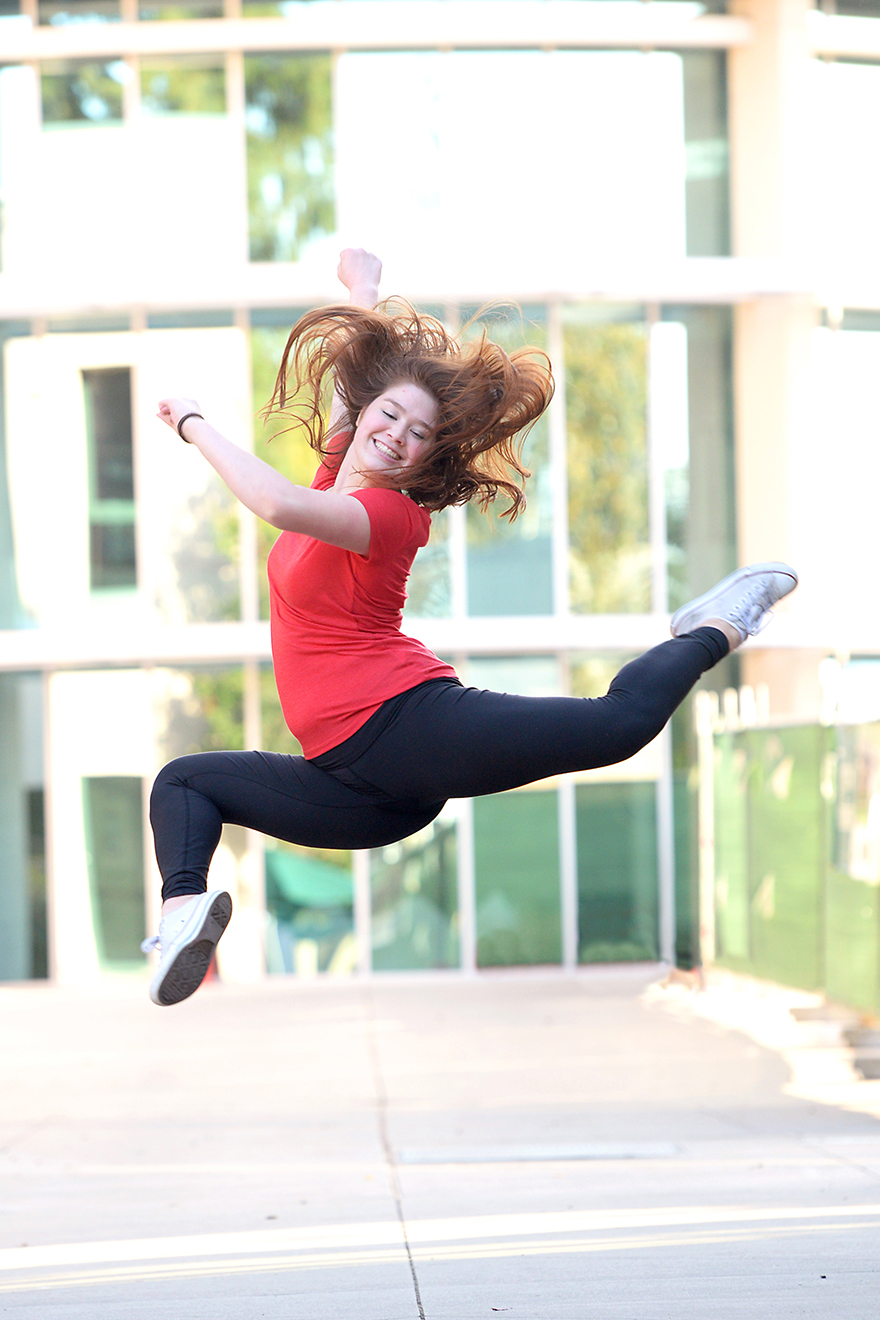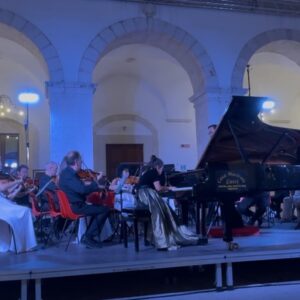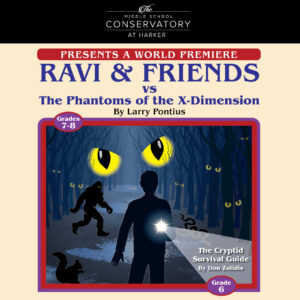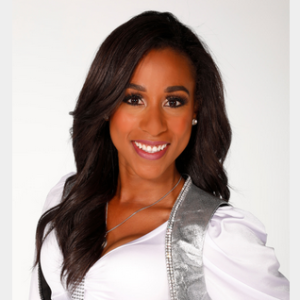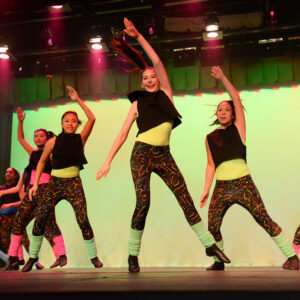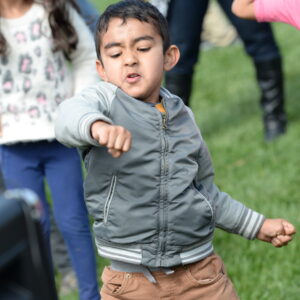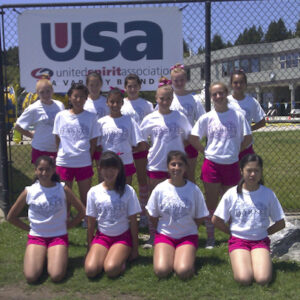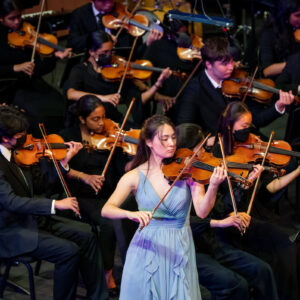This story originally appeared in the Winter 2016 Harker Magazine.
“Whenever there are extended periods of time when I am not dancing, I feel incomplete,” remarked Jacqui Villarreal ’15, who danced during her entire K-12 career at Harker and now performs with the Santa Clara University Dance Team. “As dramatic as that sounds, it’s true.” Her fervor does not appear to be uncommon. Every year, hundreds of students perform in Harker’s four major dance shows. Last year’s upper school dance production featured a cast of 140 students. That number could very well be eclipsed with this year’s show come January.
This past fall semester, “we had the most students audition for the upper school dance show that we ever had,” noted Laura Lang-Ree, Harker’s K-12 performing arts chair. “We’ve done nothing different. No new publicity, no emails.”
Harker students have been dancing for a very long time. Dance instruction was offered to students at Miss Harker’s School as early as 1903, and was introduced into the regular curriculum by the 1920s. In subsequent decades, dance instruction expanded to include Miss Harker’s kindergartners and became part of the summer programs after the school’s merger with the Palo Alto Military Academy.
Dance teacher Laura Rae further developed the dance program at Harker Academy after joining the school in the 1980s, directing routines for the spring musical and leading the after-school dance program, which started in 1983.
“[Howard and Diana] Nichols were … very passionate about performing arts overall, and Diana had a special love for dance,” said Lang-Ree, who joined Harker in 1995. The addition of the upper school brought further growth to the dance program, including some academic dance courses. Now, students K-12 can learn a wide range of styles, from ballet to jazz to hip-hop. Currently, the program boasts six audition-only dance groups across grades 4-12, each of which attracts dozens of students to auditions every year. Students dance for live audiences as early as kindergarten, and dance is one of six disciplines of focus included in the upper school Conservatory’s certificate program.
A familiar refrain among dance students and alumni is how dance classes initially just seemed like a fun activity to do with their friends. “I was new to the school in fifth grade,” recalled senior Tamlyn Doll. “I asked [my friends], ‘What are you doing after school?’ and they said, ‘Oh, I have dance.’” She opted to try it herself and “fell in love with it pretty fast,” she said.
“It seemed like a fun after-school activity and a lot of my friends were doing it,” added Villarreal. “Over the years, some people trickled out of the program, but I stayed because of how amazing the teachers are and how passionate everyone is about dancing.”
This social element has not gone unnoticed by dance faculty. “I think it’s very rewarding for them to be with their friends,” said K-8 dance teacher Gail Palmer. “They really support each other.”
Many students also discovered that dance offers a unique form of expression through movement. “I love expression in the form of physicality,” said Emre Ezer, grade 12, a performer in Harker dance shows since seventh grade. “I love pretty much every form of expression, but it’s especially fun using your own body.”
Junior Liana Wang, a member of the upper school’s Varsity Dance Troupe, said that dance is “my freedom and my expression of the soul. I find that the freedom of being able to express anything motivates me to continue the art form. I feel less restricted and bound to the expectations of the world.”
Those expectations can often be a source of stress, something students have found can be alleviated through dance. “It’s an emotional outlet,” said Hazal Gurcan, grade 12. “I feel like when I dance, my brain is kind of able to figure out what’s stressing me out.”
“Dance is the way I relieve any sort of stress, so being in college, it is a must for me to continue with it!” exclaimed Noel Banerjee ’15, a dance minor at Loyola Marymount University, where she is also a member of the dance team.
Apart from the uniquely fun and expressive nature of the art form, Harker’s support of the dance program and its faculty have played a large part in keeping students interested. Wang, who has performed with several companies and studios outside Harker, said that the Harker program’s distinct lack of competitiveness has enabled her and many other students to discover dance without feeling the pressure to impress. “From the teachers to the students, all strongly believe in helping one another for the benefit of the whole rather than for personal interests,” she said. “This has made my experience in dance much better and allowed myself to open up to the people around me.”
“One of my goals has always been to keep dance a fun and enjoyable aspect of [the students’] Harker careers,” said Karl Kuehn, upper school dance teacher. “I want dance to be a kind of creative outlet for them.”
For Doll, the nurturing and communal aspect of Harker’s dance program made all the difference. “I don’t think I would have danced at all if I hadn’t come to Harker,” she said. Having tried and disliked ballet at a very young age, she recalled doubting she would ever try dancing again. “But then when I tried it again at Harker, something about the teachers and the environment made it a lot of fun, and it’s definitely not just like any dance class.”
Other students and alumni agree. “Harker was extremely supportive with me pursuing dance in middle school, but also with my time in high school while I was in the certificate program,” said Helena Dworak ’16, now a student at Northeastern University, where she dances with the university’s audition group. “I had wonderful mentors, Karl Kuehn and [upper school dance teacher] Rachelle Haun, who completely shaped my experience in the upper school dance program.”
Another key to making Harker’s dance program welcoming is the relatively low level of commitment required. Students can commit to dancing as little as once a week and still be able to participate in a show. “It’s fun because it’s a high production value, but not necessarily a high-level commitment,” said Lang-Ree. “You can dance once a week, and fully commit to that once a week and be a part of something special as a dance show family member. And I think that’s really appealing to some kids.”
“You can just try it without having to necessarily be fully committed to it,” said Gurcan, who plans to double major in dance and psychology in college. “If the elementary school dance show had been [audition-based] then I would never have started dancing.”
The dance program also teaches its students how to make a good impression at auditions. “I think in general what we hear from our students who’ve left the Conservatory but who got their start in kindergarten, is that they know what to do when they walk into any room,” said Lang-Ree. “So they know how to handle themselves at auditions, they know how to behave in rehearsal, they know what the protocol is for being a team member in a way that not all high school students do know.”
Although technique is important, Lang-Ree stressed that how one carries oneself also gets noticed. “You want to be the nicest person in the room, who happens to be talented,” she said. “And I think that’s something that they bring to the table because they hear it from all of us from a very young age, and in the Conservatory program they hear it constantly.”
Students have noticed other benefits as well. For Wang, dance has been a way to unlock her self-confidence. “When I was younger, I use to be afraid of sharing my ideas and presenting myself in front of others since I felt like I would disappoint them and make mistakes,” she said. But through dancing and meeting choreographers and other dancers, “I was able to gain more confidence.”
Like Wang, many Harker dancers say the program gave them skills that they use in other areas of their lives.
“I have grown so much from leadership opportunities that I was given within the dance department at Harker,” said Villarreal, “and being involved in so much dance made me really good at time management.”
“It’s taught me focus, perseverance, the importance of health and wellness, and self-awareness,” said Dworak. “I am grateful that I received the support to pursue dance, as I never would have been the same person without it.”
